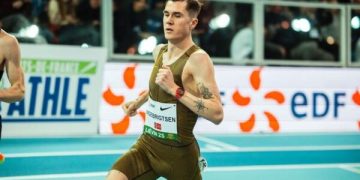
2020 U.S. Olympic Trials, the women’s start, photo by Kevin Morris
[Part II of a two-part series]
“Life is What Happens to You While You‘re Busy Making Other Plans.” — John Lennon.
This is part 2 of 2 part series on the 2020 U.S. Olympic Trials, David Hunter gives us an inside view on the top 3 women, as he had covered the top 3 men last week, and how they made the U.S. Olympic team, but also how they are dealing with the pandemic and the postponement of the 2020 Tokyo Olympics.
It makes amazing reading and gives the reader a real appreciation of the skill sets needed to make an Olympic team, but also, once one has made the team, how to manage the challenges in the modern world.
Earlier this year six American male and female athletes secured their spot on the USA Olympic team by placing among the top three finishers in the USA Olympic Marathon Trials. Amidst the joy, relief, and celebration that day, those athletes, some of USA’s earliest-selected 2020 Olympians, had no idea of the fear, the confusion, the anger, the grief, and the emotional roller coaster that would soon follow. Just about a week later the country, indeed the whole world, changed: the stock market crashed; the economy tanked; educational institutions at all levels closed; businesses were shuttered; and sports and entertainment were suspended as the COVID-19 virus gripped a world suddenly shrouded in a fog of uncertainty.
Last week’s article focused on the men. In this final segment of a two-part series, here is how the three newly-minted Olympic women marathoners, each of whom were able to call upon patience and poise to earn a place on the USA team, have handled the challenges of the new pandemic environment.
***
Going into the Trials, Sally Kipyego had a quiet confidence about her chances to make the U.S. Olympic team, even win the race. “I was really in good shape. And I thought I had a chance to make the team, explains the former Texas Tech star, whose outlook was elevated by her sterling 2:25:10 clocking in the ’19 Berlin Marathon – an all-time top-ten USA women’s performance. “I went in with the confidence that I could win the race. And I went into the race to win. Still, anything can happen in the marathon. If things didn’t go so well, I thought I would still make the team. I knew it was not going to be an easy race. And it felt even more difficult than I expected.”
 Sally Kipyego, 2020 U.S. Olympic Trials, photo by Kirby Lee
Sally Kipyego, 2020 U.S. Olympic Trials, photo by Kirby Lee
As the women’s race unfurled, and after a tempered first half, the race to make the Olympic team became difficult in the 19th mile as Molly Seidel crept away, later joined by Aliphine Tuliamuk. ” I was anticipating that kind of a move. Everybody knew the end of the race was going to be hard. When the move happened, it kind of caught me off guard,” explains the 2012 Olympic silver medalist at 10,000 meters. “I wanted to go with it and I realized the pace would be hot after that. And I wanted to make sure I could hold it together for the final 6+ miles. I felt that if I committed with that move, I would feel too much lactic in my legs and I wouldn’t be able to finish at the end of it. So I made a judgment call to hold back to my own pace. That way I could finish the race in one piece. It can be brutal over the last three miles of the race. And I knew I needed a little bit more in the tank to finish the way I wanted to.”
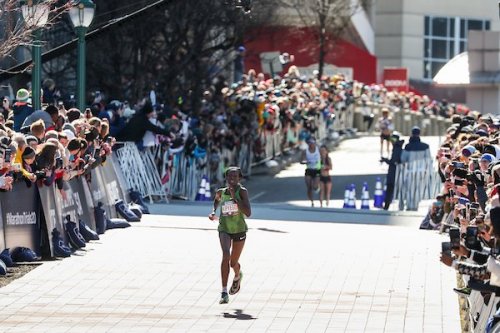 Sally Kipyego, 2020 U.S. Olympic Trials, photo by Kevin Morris
Sally Kipyego, 2020 U.S. Olympic Trials, photo by Kevin Morris
With Tuliamuk and Seidel working in tandem and in the clear, all eyes were on the trio of Kipyego, Laura Thweatt, and two-time Olympic marathoner Desi Linden as they fought for the 3rd and final place on the USA women’s marathon team. “It was brutal, there is no way around it,” declares Kipyego as she describes the war for the final ticket to Tokyo. “If you look at the splits it was kind of ridiculous as we were running 6 minute pace the last few miles of the race. I am a huge fan of Desi. She’s a great athlete. And I know she closes fast. Something that really surprised me is that she couldn’t catch me. We were all dying. And everybody was trying to manage themself. I am glad that I was able to do as well as I did and make that team.” Her split-second decision to not cover Seidel’s move vindicated, the Oregon Track Club athlete grabbed 3rd to secure her first U.S. Olympic berth, 11 seconds ahead of Linden with Thweatt another 5 seconds back.
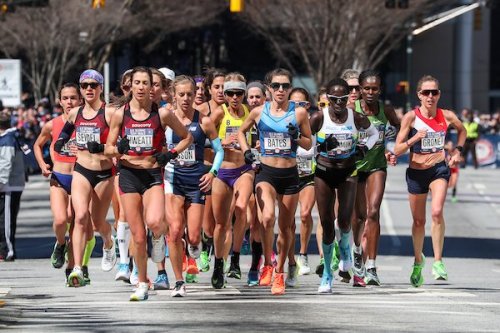 Mid race, the top pack, 2020 U.S. Olympic Trials, photo by Kevn Morris
Mid race, the top pack, 2020 U.S. Olympic Trials, photo by Kevn Morris
After post-race celebrations concluded, Kipyego met with her long-time coach and mentor Mark Rowland to discuss the big-picture approach leading up to the Games. “After the race we didn’t talk about Olympic plans,” explains the Kenya-born athlete who, along with her husband Kevin Chelimo and her 2-year old daughter Emma, splits time between Eugene and her family home in her native country. “We were going to take a month off so I could spend time with my family in Kenya. I then was supposed to travel back [to Eugene] in April to get ready for the Olympics. That was the plan just at the onset of the pandemic. We didn’t expect that something of this kind was going to happen the way that it did happen.”
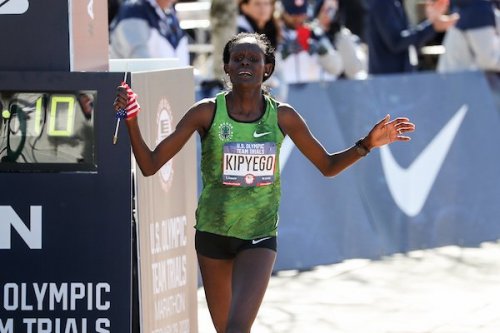 Sally Kipyego makes the team, 2020 U.S. Olympic Trials, photo by Kevin Morris
Sally Kipyego makes the team, 2020 U.S. Olympic Trials, photo by Kevin Morris
As the surge of the global pandemic forced changes, Kipyego, who gained her U.S. citizenship in 2017, did not return to the U.S. in April. Sequestered in Kenya and separated from the coach she’s worked with since she turned pro, Sally was compelled to improvise, to change up her schedule and her training. “We’ve just been trying to run a little bit in this situation and studying what is the best way forward. We had general plans on getting ready to run the marathon,” assures the 9-time NCAA champion. “I trained through July with the idea that I was just training for a 5K . I didn’t want to strain myself too much. [Coach Rowland and I planned to] get together during the end of July to put together a plan for the marathon. I was thinking I would run the marathon in Boston [on its alternate September 14th date] or New York. That was the plan,” notes Sally with a pause. “But then those races were cancelled. After that, the plan changed to train to getting ready for next year. And that’s where we are at the moment.” Kipyego is working on devising plans to get back to Oregon for a reunion with Rowland and some more focused training. “In Kenya, we just opened the airports,” she notes. “I am thinking that I might next travel in September.”
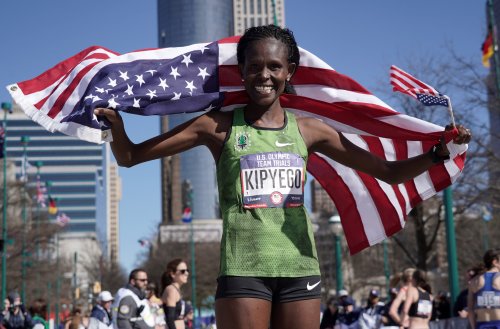 Sally Kipyego, 2020 U.S. Olympic Trials, photo by Kirby Lee
Sally Kipyego, 2020 U.S. Olympic Trials, photo by Kirby Lee
A seasoned professional at age 34, Kipyego knows how important 2021 will be. “Next year is going to be a big year,. So you want to pace yourself so you get to next year healthy and together. I am training: I’m doing long runs; road runs; I’m basically training like I’m training for a 10K or a half marathon. I’m not training for a marathon because that means a lot of work and beating down your body too much. And I don’t want to do that given the plans we have for next year,” she explains. “When next year comes around I want to be healthy, strong, and fresh and be able to take my body through really hard sessions and in meetings leading up to the Olympics. I want to be in the best shape I can be.” After a pause and to be clear, the 2011 World Championship silver medalist at 10,000 meters adds, “And if I don’t take care of my body right now, I’m not going to be able to be ready for next year. That means training, but not running yourself into the ground.”
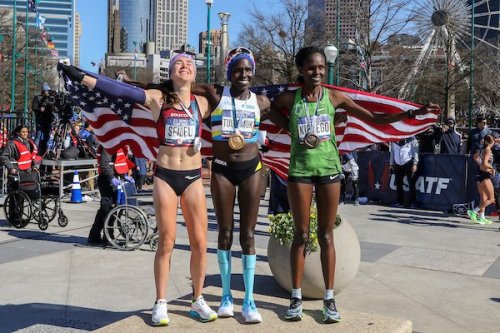 Molly Seidel, Aliphine Tuliamuk, Sally Kipyego, 2020 U.S. Olympic Trials, photo by Kevin Morris
Molly Seidel, Aliphine Tuliamuk, Sally Kipyego, 2020 U.S. Olympic Trials, photo by Kevin Morris
Sally Kipyego, who has long ago proved unflappable when racing on the track and the road, can easily explain how she keeps her poise in dealing with the ever-changing and uncertain times in this COVID-19 era. “I am lucky that I have had a decent and long career. I think those experiences help you and give you just a little bit of confidence and put things into perspective,” notes Sally as she explains that everyone must find their reliable source of strength. “For me, it’s being a mom. Children have a way of putting things into perspective. Running is so amazing and this is what we do and this is my life at the moment which is fantastic. I get to celebrate that. So even if the Olympics get cancelled next year, it is still amazing the things that are going on: I got to run a marathon this year. My friends who trained for a spring marathon didn’t get to run. I still have a job. I am happy. I am spending time with my family. Even if things do not go as planned, there are still many things to be grateful about. And that helps as we learn how to live in these pandemics. Even when things don’t go as planned you still have so many other things that are wonderful for you and haven’t affected you as much as other people. Those little thing and those big things to be grateful about help you look at this pandemic from a good point of view.”
***
What do you say about an athlete who has a celebrated career as a collegian; spends the next 3-4 years going through and adhering to the guidelines of an eating disorder program; undergoes surgery to correct a broken pelvis (a byproduct of her disorder) followed by 6 months of sedentary recovery; resumes serious training under a new coach to prepare for the USA Olympic Marathon Trials just 5 months away; runs a half marathon 10 weeks before the Trials – a her first ever road race longer than 10K – and runs 1:10:26; races her 2nd half 6 weeks from the Trails (improves to 1:09:35); competes in the marathon Trials, makes the critical move late in the race; finishes 2nd (8 seconds behind the winner); becomes the first American woman to make the USA Olympic marathon team while running her first full marathon; and runs negative splits! Who does that? The answer is: an extremely talented and determined athlete, Molly Seidel.
 Molly Seidel, Aliphine Tuliamuk, 2020 U.S. Olympic Trials, photo by Kevin Morris
Molly Seidel, Aliphine Tuliamuk, 2020 U.S. Olympic Trials, photo by Kevin Morris
How in the world did Seidel rise above all of this adversity in the space of 5 months to make the Olympic team in an event in which she had never competed? “Looking back, last fall was so interesting because there were so many changes in my life. I got into a better living situation here in Boston. I switched to Jon [Green] as my coach. We started doing this just radically different training and racing that I had been doing the previous several years,” explains the Saucony athlete. “It was just kind of wild. Things just started clicking a little bit. For a long time, I had been doing things a certain way because I thought that was the right way to do things. The proper progression in the sport is seen as the route where you race the 5K at the world level for a couple of years, then move up to the 10K, and then move up to the marathon. I think we realized that linear progression wasn’t for me.” But Molly, not one to be handcuffed by traditional norms, was ready to explore a new approach. “I kind of knew I wanted to do this longer stuff and that my body handled that kind of training better. We might as well try it out. Why wait until I’m 33 to do a marathon?” the 26-year-old asks rhetorically. “We kind of know that this is where I want to be. It was definitely wasn’t looking like I’d make the team in the 5K or the 10K at that point. We figured we’d do the marathon training and try to back our way in and see if I could maybe squeeze onto the 10K team. That would be the option.” And then, still almost disbelievingly, she adds, “Then all of a sudden I make the marathon team.”
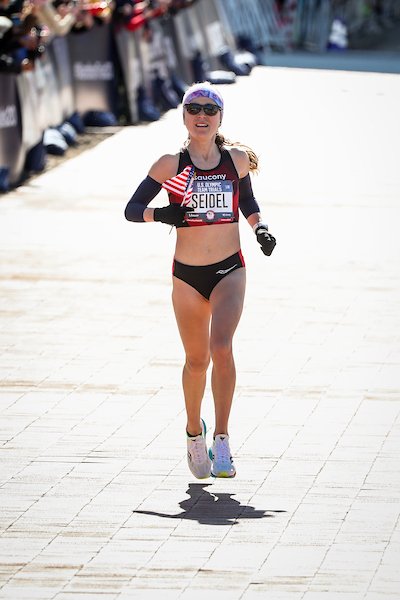 Molly Seidel takes second, 2020 U.S. Olympic Trials, photo by Kevin Morris
Molly Seidel takes second, 2020 U.S. Olympic Trials, photo by Kevin Morris
Leading up to the day of the Trials race, Seidel didn’t worry about her prospects. She didn’t have any. “To be fair, I wasn’t even thinking about that. The point of the race wasn’t to make the team per se. It was just that we could have a really good run while we’re there. And I knew it was going to be highly competitive. I knew I had a higher probability of getting my ass kicked than making the team. I was just going into it with the attitude of just being as crafty as I can and just beating as many people as I can. Before the start I would have said getting 5th would have been the race of my life. I was trying to be competitive and see what I could do.” But as the race unfolded and Molly was right in the mix, the attitude of the former NCAA 10,000 meter champion began to change, but not by much. “All of a sudden we’re around 19 miles and Aliphine and I are in the front. And I thought, ‘Whoa, now you’re in it.’ But it was the same attitude I would have had if I was in 10th place. That’s why I think I was able to keep it going. Making the team, frankly, didn’t matter at that point. I just wanted to beat as many people as I possibly could.”
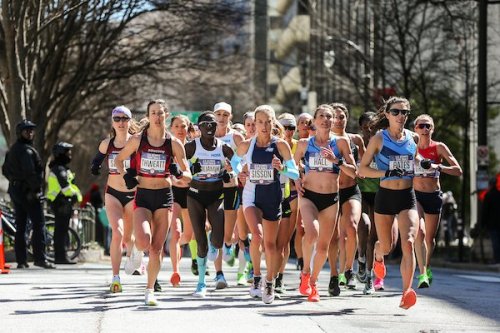 Molly Seidel, outside, 2020 U.S. Olympic Trials, photo by Kevin Morris
Molly Seidel, outside, 2020 U.S. Olympic Trials, photo by Kevin Morris
And then the rookie made the decisive move of the race. “It really wasn’t a conscious move,” claims the Heartland, Wisconsin native. “We were going up a small incline coming back down Peachtree and all of a sudden I found myself right in the front – a meter or two in front of the pack. But I just wanted to keep running the pace I wanted to run right then because I was feeling strong and I didn’t want to slow down.” Seidel’s cadence strung out the lead pack. “Aliphine closed on me in 400 meters and we hit mile 19 together. We kind of knew that this was it. We started going. And when we hit 22 miles we started rolling.”
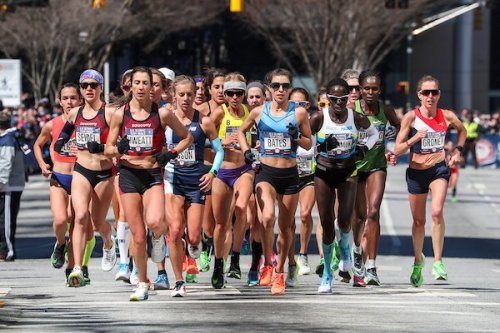 The pack , Molly Seidel on outside, 2020 U.S. Olympic Trials, photo by Kevin Morris
The pack , Molly Seidel on outside, 2020 U.S. Olympic Trials, photo by Kevin Morris
Working together, the seasoned 10-time USATF road race champion and the newbie were creating separation, coaxing each other on with occasional conversation. “It was not like we were waxing poetic,” laughs Molly. “She was encouraging me, ‘Come on we can do this.’ And I’d reply, ‘I’m with you, I’m with you.’ That’s about all I could get out because I was really hurting at that point,” explains Seidel. “But having her there and knowing that she was working with me helped me so much. She knew that if we ran together it would make both of us stronger.” Remembering the hard work, the holding on, and her reliance on Tuliamuk’s encouragement in those final miles, Seidel offers this confession: “If she had wanted to, she could have dumped my ass so easily.”
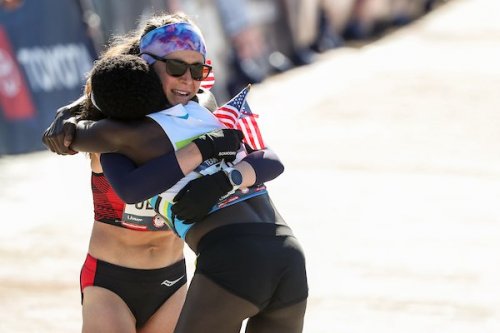 Molly Seidel and Aliphine Tuliamuck, 2020 U.S. Olympic Trials, photo by Kevin Morris
Molly Seidel and Aliphine Tuliamuck, 2020 U.S. Olympic Trials, photo by Kevin Morris
In final kilometer, Seidel allowed herself to recognize what was happening. “It’s about 600 meters to go when they give you this tiny little American flag. And then you finally start going downhill over the final 400 meters. And that was when I realized, ‘Oh my God, is this really happening? I’m making this team!’ It was pretty incredible,” explains Seidel with enthusiasm. “I know the crowd was deafening. But I couldn’t hear anything. I was so happy.”
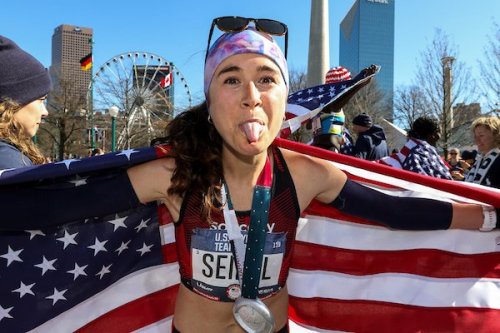 Molly Seidel, 2020 U.S. Olympic Trials, photo by Kevin Morris
Molly Seidel, 2020 U.S. Olympic Trials, photo by Kevin Morris
After a joyful post-race celebration [“We drank all the beer.”] Molly and Coach Green sat down the following day for a conversation neither could have expected: to craft a Tokyo Olympics plan. “We did a brief overview of what we were thinking, what recovery was going to look like. We were hoping in time to put together a plan,” explains Molly. But the virus was lurking, making its way to the USA. “We kind of knew what it was going to be. We knew if there wasn’t going to be any racing during the spring and summer that there was just no way they were going to be able to hold the Olympics. And by mid-March it was becoming pretty clear this [the Olympic Games postponement] was going to happen.” And when the Games were officially postponed on March 24th there were even moments of concern that 2020 Olympian status might be in question for the 6 top marathon performers. “It was up in the air at the end of March whether or not we would be able to keep our spots on the team. We had to get confirmation from USATF,” states Seidel, her Olympian status long since re-affirmed. “And that was a very stressful time. We were super freaked out.”
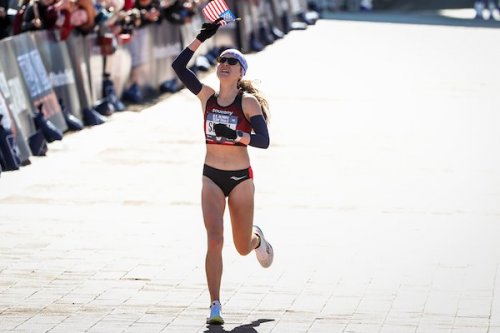 Molly Seidel, 2020 U.S. Olympic Trials, photo by Kevin Morris
Molly Seidel, 2020 U.S. Olympic Trials, photo by Kevin Morris
For the new Olympian and her coach, it was back to the drawing board. “For a while it really was just about trying to figure out and get through the times here in Boston. We had ‘stay at home’ orders. Training was very difficult. The tracks were shut down. You couldn’t run outside without a mask. And obviously there was the huge disappointment,” recalls Seidel of the change and confusion that gripped Boston, and the entire country. “There were no races on the horizon. We were just trying to get through the day-to-day. We were just trying to get some base training in. We knew that everything was liable to be changed or cancelled. We were trying not to put too much stock in anything,” outlines Molly with a tinge of sorrowful disbelief in her voice. “We’ll figure it out. We’ll use the extra year to just get as strong as we can.”
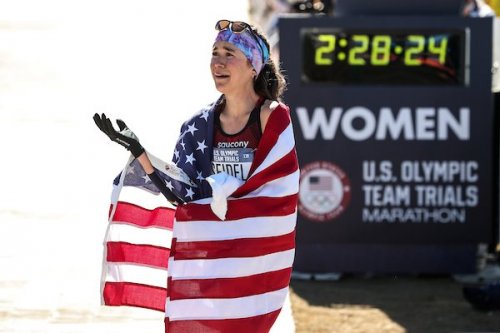 Molly Seidel, 2020 U.S. Olympic Trials, photo by Kevin Morris
Molly Seidel, 2020 U.S. Olympic Trials, photo by Kevin Morris
Seidel, a seasoned sailor during her youth, has brought a resilient attitude to the present COVID-19 environment. “You’re never going to be able to change the conditions that you’re in. The world is just going to go on. The most you can do is change your attitude on how you respond,” offers the young professional. “When I was growing up, I did a lot of sailing. From sailing, I learned that you can’t ever change the direction of the wind. But you can adjust your sail. Your attitude is the only thing you can control. The world is absolutely crazy now. I can have a crappy attitude and that’s not going to help anyone. A year ago I was barely running and not sure that I was going to keep doing this at the pro level. I love what I do. And every day I get to go out and run and do what I like to do is a good day.”
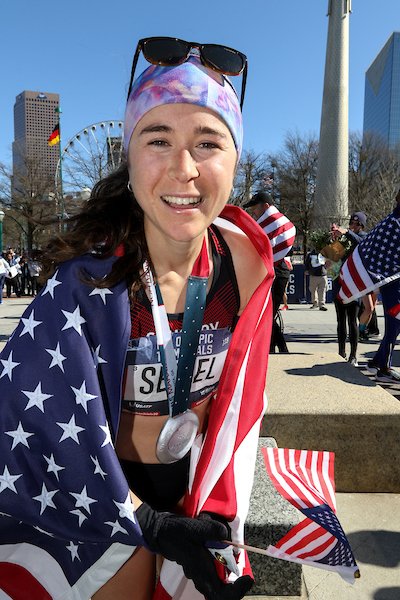 Molly Seidel, 2020 U.S. Olympic Trials, photo by Kevin Morris
Molly Seidel, 2020 U.S. Olympic Trials, photo by Kevin Morris
And so, a healthy and invigorated Olympic athlete and her new coach soldier on as they prepare for Molly Seidel’s Olympic marathon race next year. If you think Seidel’s steep learning and performance curve in Atlanta was amazing, perhaps never again to be matched, may I remind you of this: While at Norte Dame, Molly competed all four years in the NCAA Division I Cross Country Championships. Here’s how she did: Freshman year: 217th; Sophomore year: 171st; Junior year: 19th; Senior year: 1st – to become the first female Foot Locker champion to go on to win the NCAA Div. I cross title. Her jaw-dropping progression isn’t just The Luck Of The Irish. Seidel is a brave, quick-learning talent. And consider this: the next time she runs the marathon she will be equipped with aids she lacked in Atlanta: almost a full year of additional marathon training before the Tokyo Games; a proper marathon buildup; new-found confidence; experience from her Trials success. Over the past year, Molly Seidel has been attending to her jib and adjusting her mainsail. Her competitors should be worried.
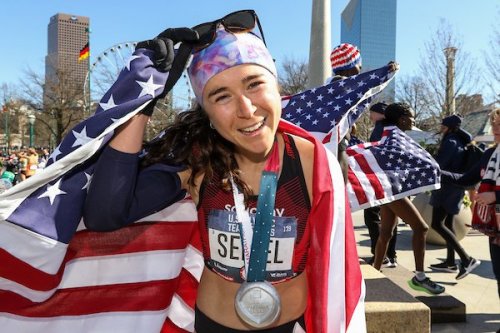 Molly Seidel, 2020 U.S. Oympic Trials, photo by Kevin Morris
Molly Seidel, 2020 U.S. Oympic Trials, photo by Kevin Morris
***
By the time Aliphine Tuliamuk arrived in Atlanta for the Trials race, she liked her chances of making the U.S. Olympic team. “I knew that my training had gone really well,” she confides. “The course was one of the hardest courses that they had ever had [for the Trials]. The conditions, the weather weren’t ideal. So I definitely knew that it was anyone’s race. And I’ve always done really well when the conditions are not ideal and when the course is hard. So I knew that I had a chance.” But the race still had to be run. And as a veteran athlete she knew that anything can happen in a competition over 42+ kilometers. “A lot of times, it’s not just your fitness that matters. There’s not a lot of room for error in the marathon. It just has to be your day.”
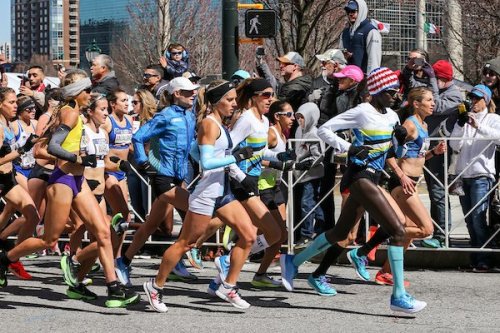 Aliphine Tuliamuk, 2020 U.S. Olympic Trials, photo by Kevin Morris
Aliphine Tuliamuk, 2020 U.S. Olympic Trials, photo by Kevin Morris
And the day of the Trials did prove to be her day as the 10-time USATF road champion made all the right moves, won the race, and made her first Olympic team. The Kenyan native recalls the critical moment: just before the 20th mile as Molly Seidel sneaked into the lead. “When she [Seidel] took the lead I then realized that she was breaking away and I thought, ‘This is the time. Go with her.’ After covering her move I told her, ‘We need to go right now.’ I realized that this was the moment. I had this feeling that I was strong, but I didn’t really have any plans. I was just going with the flow basically.” Her instincts proved right as the duo, unchallenged and working in tandem,, separated quickly from the pack. “At the end of the marathon it is really hard. And when you have the chance to work with someone it is definitely the best, especially on a course like that and with conditions like that. I knew that if we worked together we had a greater chance of making the team.” Tuliamuk was able to summon one final burst in the last mile to capture the victory. “When we got to about a mile to go I decided that I would give myself a shot to win the race. And that is when I started to make my final move.”
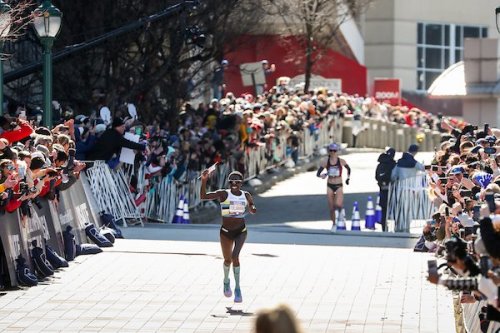 Aliphine Tuliamuk wins 2020 U.S. Olympic Trials, photo by Kevin Morris
Aliphine Tuliamuk wins 2020 U.S. Olympic Trials, photo by Kevin Morris
Afterwards, the new Olympian met with her coach Ben Rosario of NAZ Elite to craft plans leading up to Tokyo’s Olympic Games and beyond. We sat down and we kind of mapped out the rest of the year,” explains the Trials champion. “We had a couple of weekends for races at 10K – including the Bolder Boulder – and then we were planning to get ready for the marathon at the Olympics. That was our plan. And then after the Olympics we were planning for [a fall marathon / the New York City Marathon]. We had a plan for the entire year,” she summarizes. And then she grimly reminds, “That only lasted about a week.”
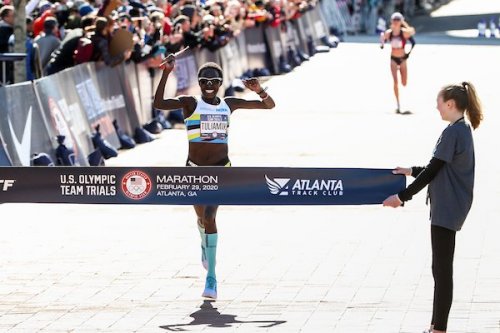 Aliphine Tuliamuk takes 2020 U.S. Olympic Trials, photo by Kevin Morris
Aliphine Tuliamuk takes 2020 U.S. Olympic Trials, photo by Kevin Morris
As the reality of the pandemic emerged and spread, Aliphine went through successive stages of disbelief, confusion, clarity, and ultimately resolution. “In the beginning, I thought that it was probably going to last for a couple of hours and we would soon have things back on track. But before long it occurred to me: ‘Is the 2020 Olympics going to happen?'” The Trials champion had to face the new reality. “Looking at what had happened in the few months before and how much we still had to go, I just knew that 2020 [Olympic Games] just couldn’t happen.”
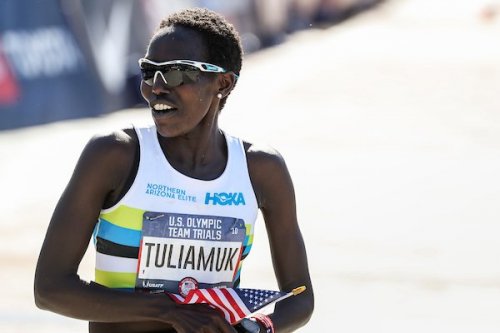 Aliphine Tuliamuk, 2020 U.S. Olympic Trials champion, photo by Kevin Morris
Aliphine Tuliamuk, 2020 U.S. Olympic Trials champion, photo by Kevin Morris
In searching for the way forward, Tuliamuk, who gained U.S. citizenship in 2016, found acceptance and gratitude. “I knew there was nothing I could do,” she admits. “Really there were just a lot of people, other than the 6 of us who made the team, who were really impacted by this. The 6 of us were in a much better place, we really shouldn’t be complaining: we had a big day; we made the team. And there are a lot of people in our profession who never even got a chance to race. Compared to a lot of athletes, I knew I was in a better place. And I kind of looked on the bright side of things; that I was lucky that I won the race, that I made the team, and there was nothing I could do. I was sad. But I just had to find a way to stay positive.”
 Aliphine Tuliamuk, 2020 U.S. Olympic Trials, photo by Kevin Morris
Aliphine Tuliamuk, 2020 U.S. Olympic Trials, photo by Kevin Morris
A component of staying positive was assembling a new plan with Coach Rosario. “Ben [coach Rosario] and I just decided that I was just going to train for maintenance,” explains Aliphine who has gone back to New Mexico. “I not going to run in a group for fear of catching the virus, or run a fast mile, or anything like that. I’m just going to continue to train and put in the work. I’ll keep myself in shape so that when races do come back it will allow me to definitely sharpen up and I’ll be ready. So that is what we have been doing: still training; running 80-85 miles a week; weekly 20-mile long runs, but nothing intense. Compared to what I used to be doing, I am just doing the bare minimum right now just to make sure I stay in shape.”
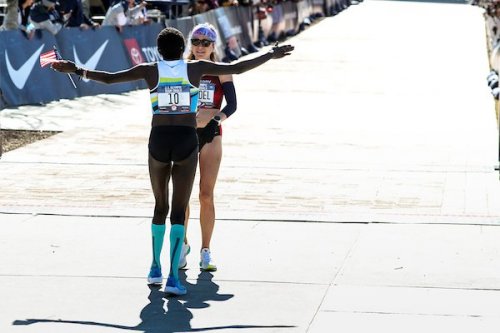 Aliphine Tuliamuk embraces Molly Seidel, 2020 U.S. Olympic Trials, photo by Kevin Morris
Aliphine Tuliamuk embraces Molly Seidel, 2020 U.S. Olympic Trials, photo by Kevin Morris
Wisely, the former Wichita State star is purposely nonspecific about her return to competition. “I am going to continue to do what I’ve been doing. I think my next race will be when it is safe, and no more virus comes back to concern us,” Aliphine admits. “I don’t think I’ll be racing for the rest of this year,”
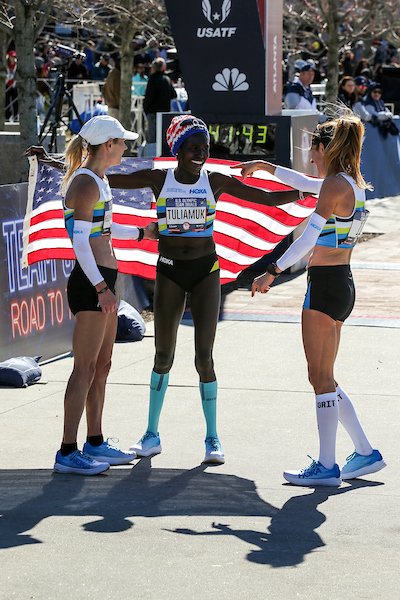 Kellyn Taylor, Aliphine Tuliamuk, Stephanie Bruce, 2020 U.S. Olympic Trials, photo by Kevin Morris
Kellyn Taylor, Aliphine Tuliamuk, Stephanie Bruce, 2020 U.S. Olympic Trials, photo by Kevin Morris
Tuliamuk stays in close contact with her large family in Kenya. “My family is doing well so far. “They haven’t been affected by the virus which is great news,” offers Aliphine who is one of 32 children.” The virus is spreading very fast in Kenya so I am just hoping that it stops spreading and never reaches where my parents are.”
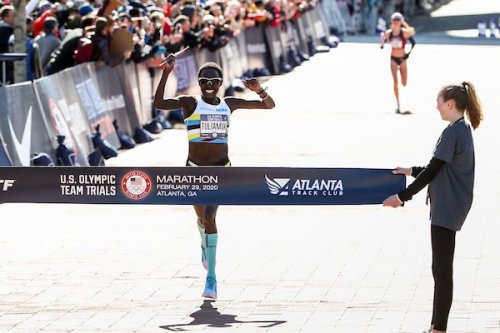 Aliphine Tuliamuk, Molly Seidel, go 1,2, 2020 U.S. Olympic Trials, photo by Kevin Morris
Aliphine Tuliamuk, Molly Seidel, go 1,2, 2020 U.S. Olympic Trials, photo by Kevin Morris
Aliphine Tuliamuk, the Trials champ and new Olympian who kept her cool when the Trials race got hot, has embraced an attitude that gives her serenity. “When you realize that this [global pandemic] is affecting a lot of other people dealing with a lot of sudden suffering, you suddenly you realize that your problems aren’t as big as you once thought. It just puts things into perspective: I’m healthy; I work out; and I am glad and very happy that I can still go outside and run. My life hasn’t changed that much except for the fact that I’m not having these races. And that helps a lot. I can’t really complain too much.” Dave Hunter
Author

Dave Hunter is an award-winning journalist who is a U.S. Correspondent for Track & Field News. He also writes a weekly column and serves as Senior Writer for www.RunBlogRun.com, and covers championship track & field competition domestically and in such global capitals as Moscow, Birmingham, Zurich, Brussels, Beijing, Rio de Janeiro, Zagreb, Ostrava, and Doha. Hunter frequently serves as the arena or stadium announcer for championship track & field gatherings, including the Ivy League, the Big East, the Mid-American Conference, the NAIA, the Big Ten, and the Millrose Games. Hunter has undertaken foreign and domestic broadcast assignments. He ran his marathon P.R. 2:31:40 on the Boston Marathon course back in the Paleozoic Era. To find out more about Dave, visit his website: www.trackandfieldhunter.com He can be reached at: dave@trackandfieldhunter.com
View all posts





